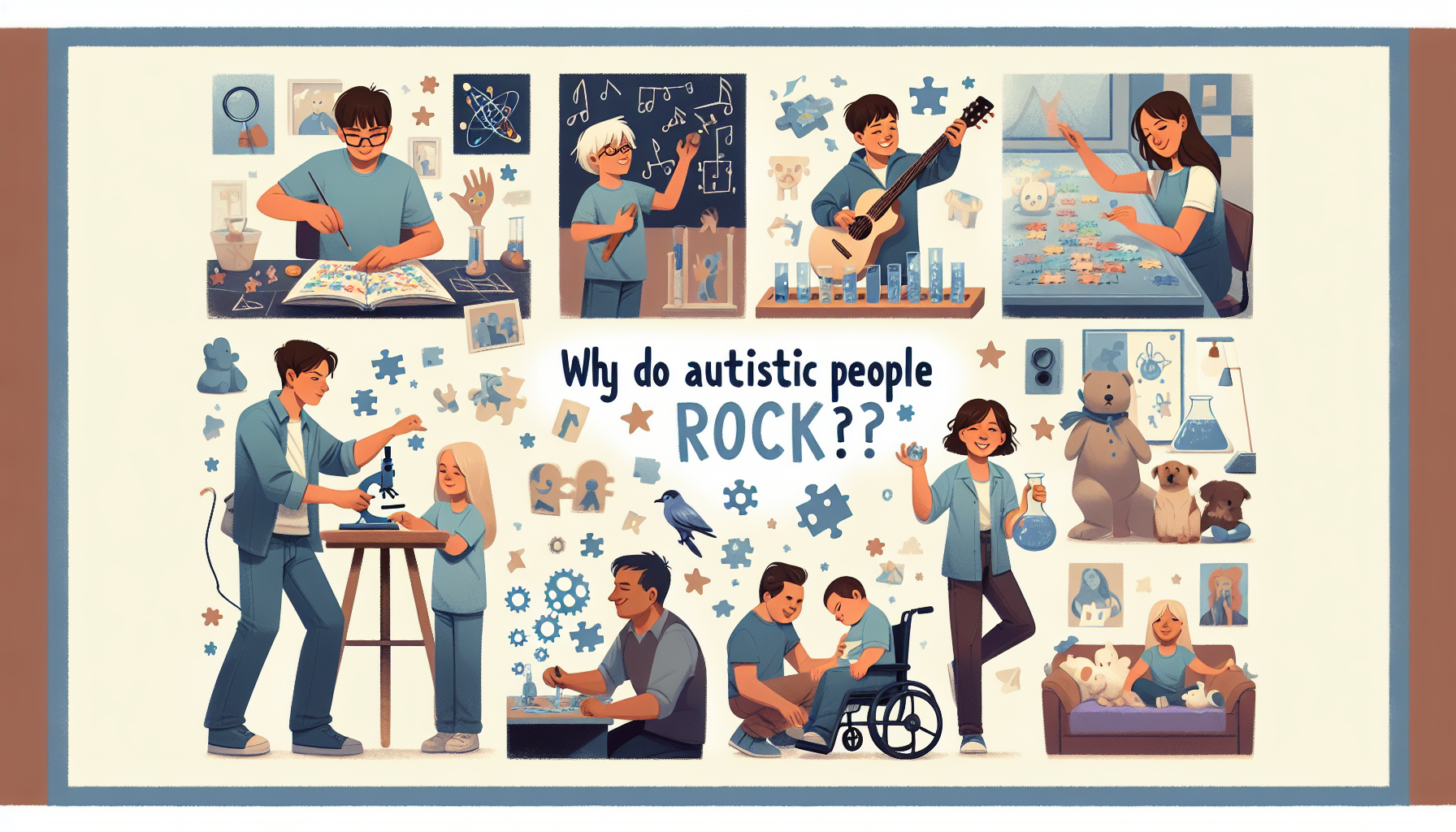Understanding Autistic Rocking
Autistic rocking is a behavior commonly observed in individuals on the autism spectrum. This repetitive motion can involve rocking back and forth or side to side, and it often serves as a way for autistic individuals to self-regulate and find comfort. In this section, we will delve into the observations on rocking behaviors and explore the differences in rocking patterns between autistic individuals and typically-developing individuals.

Observations on Rocking Behaviors
Research has shown that there are distinct differences in rocking behaviors between autistic individuals and typically-developing individuals. In a study conducted by NCBI, it was found that typically-developing children exhibited spontaneous social rocking with their caregivers, while children diagnosed with autism spectrum disorder (ASD) did not demonstrate a tendency to rock in a symmetrical state with their parents. This suggests that the purpose and expression of rocking may vary between the two groups.
Furthermore, the study found that autistic children rocked an average of 42.0% of the time during the trials, while typically-developing children rocked an average of 47.9% of the time. Although the difference in rocking duration was relatively small, it highlights the prevalence of rocking behaviors among both groups.
Differences in Rocking Patterns
One notable difference in rocking patterns between autistic individuals and typically-developing individuals is the coordination of rocking with others. Typically-developing children spent more time rocking in-phase with their parents compared to children with ASD, suggesting a difference in perceptual or motoric processes.
It’s important to note that the rocking behavior observed in autistic individuals is not necessarily an indication of developmental delays or intellectual abilities. In fact, intellectual age, as measured by Mullen scores, was significantly correlated with in-phase rocking in both typically-developing children and children with ASD. This suggests that the presence or absence of rocking behaviors is not solely determined by cognitive abilities.
Understanding these observations and differences in rocking behaviors can help us gain insight into the unique experiences of autistic individuals. While rocking may serve as a means of self-regulation and comfort, it is essential to approach it with understanding and acceptance, recognizing that it is a natural expression of individuality and neurodiversity.
The Function of Rocking in Autism
Rocking behavior is a common form of “stimming” among autistic individuals. Autistic individuals may engage in rocking behavior to close out the world, limit outside stimulation, provide a sense of comfort and predictability, and help cope with overwhelming sensory input. The function of rocking in autism can be understood through its role in sensory regulation and emotional comfort.
Sensory Regulation through Rocking
Rocking behavior serves several functions related to sensory regulation, creating a more manageable sensory experience for individuals with autism. It provides a predictable and repetitive sensory input, helping individuals feel more grounded and in control of their surroundings. The rhythmic motion of rocking can block out overwhelming sensory stimuli or create a sense of familiarity and comfort in sensory-rich environments.
By engaging in rocking, individuals with autism can self-regulate their sensory experiences, finding a balance between sensory overload and sensory deprivation. This self-regulation helps them navigate sensory-rich environments more effectively and maintain a sense of calm.
Emotional Regulation and Comfort
In addition to sensory regulation, rocking behavior plays a significant role in emotional regulation and comfort. Rocking back and forth can have a calming effect on the nervous system, reducing anxiety and stress. It provides a sense of comfort and security, allowing individuals to self-regulate their emotions and find a state of relaxation [3].
For some individuals with autism, rocking serves as a self-soothing mechanism during times of stress or anxiety. The repetitive motion and rhythm of rocking can help them achieve increased attention and cognitive processing, enabling them to better focus on tasks or activities. Rocking can also serve as a means of communication and expression, allowing individuals to convey their feelings, needs, or desires when verbal communication is challenging.
By understanding the function of rocking in autism, we can appreciate its role in providing sensory and emotional regulation. Recognizing and accepting rocking behaviors as a natural aspect of autistic individuals’ self-expression can contribute to creating a more inclusive and supportive environment for them.
Challenges and Implications of Rocking
While rocking behavior in autism serves important functions for sensory and emotional regulation, it can also present challenges and implications for autistic individuals. These challenges include the social stigmatization of rocking and its impact on daily activities.
Social Stigmatization of Rocking
Society’s lack of understanding and acceptance of autistic behaviors can lead to negative judgments and exclusion, with rocking behavior being no exception. The repetitive and rhythmic movements of rocking can draw attention, potentially causing discomfort or confusion in others. As a result, autistic individuals may face social stigmatization, with their rocking behavior being misunderstood or judged as abnormal or strange.
It is important to recognize that rocking is a self-soothing mechanism for many autistic individuals, allowing them to regulate sensory input and manage overwhelming emotions. Instead of stigmatizing rocking behavior, society should strive to foster a more inclusive and accepting environment that embraces the diverse behaviors and needs of autistic individuals.
Impact on Daily Activities
Excessive rocking can sometimes interfere with daily activities and tasks. While rocking can provide comfort and a sense of calm, it may also disrupt focus or engagement in certain situations. For instance, in educational or work settings, excessive rocking might draw attention away from the task at hand or create challenges in maintaining concentration.
It is crucial to approach these challenges with understanding and support. Providing autistic individuals with appropriate accommodations, such as sensory breaks or alternative seating options, can help minimize the impact of rocking on daily activities. By creating an environment that considers the individual needs and preferences of autistic individuals, we can encourage their full participation and engagement in various activities.
Understanding the challenges and implications of rocking behavior in autism allows us to foster a more inclusive and supportive society. By promoting acceptance, raising awareness, and providing appropriate accommodations, we can create an environment that embraces the unique characteristics and needs of autistic individuals, enabling them to shine and thrive.
Exploring Stimming in Autism
Stimming, short for self-stimulatory behavior, is a term used to describe repetitive behaviors exhibited by individuals with autism. These behaviors can take various forms, including hand flapping, rocking, spinning, or making repetitive noises. Stimming serves several important purposes in the lives of autistic individuals, including sensory regulation, emotional regulation, communication, and self-soothing [2].
Definition and Types of Stimming
Stimming behaviors can be categorized into different types, and the specific behaviors can vary from person to person. Some common types of stimming include:
- Hand Flapping: This involves repetitive movements of the hands, such as rapidly opening and closing them. It is a common form of stimming that autistic individuals may engage in to express excitement, relieve stress, or regulate sensory input.
- Rocking: Rocking behavior is a prevalent form of stimming among autistic individuals. It typically involves rhythmic back-and-forth movements of the body while seated or standing. Autistic individuals may engage in rocking behavior to close out the world, limit outside stimulation, provide a sense of comfort and predictability, and help cope with overwhelming sensory input.
- Spinning: Some individuals with autism may engage in spinning behavior, where they repeatedly rotate their bodies or objects. Spinning can provide a sense of sensory input and help individuals regulate their sensory experiences.
- Repetitive Noises: Making repetitive vocal sounds or noises, such as humming, squealing, or repeating certain words or phrases, is another common form of stimming. It can serve as a way for individuals to self-regulate or communicate their feelings.
Reasons Behind Stimming Behaviors
Stimming behaviors serve several functions related to sensory regulation, emotional regulation, and cognitive processing. Autistic individuals engage in stimming for various reasons, including:
- Sensory Regulation: Stimming behaviors can provide sensory regulation and create a more manageable sensory experience. Autistic individuals may stim to either seek sensory input or avoid overwhelming stimuli in their environment. For example, rocking can help individuals with autism maintain a steady level of sensory input and create a sense of predictability.
- Emotional Regulation: Stimming can serve as a self-soothing mechanism during times of stress, anxiety, or overstimulation. Engaging in repetitive behaviors helps individuals with autism regulate their emotions and find comfort and relief in challenging situations.
- Communication: Stimming behaviors can also serve as a form of communication. Autistic individuals may use stimming to express their emotions, needs, or preferences. For example, hand flapping may indicate excitement or joy, while rocking may signal a need for comfort or self-regulation.
- Cognitive Processing: Stimming behaviors might aid in attention and cognitive processing. The repetitive movements or sounds can help individuals with autism focus, concentrate, and process information more effectively.
Understanding the definition and types of stimming, as well as the reasons behind these behaviors, is essential for supporting and accommodating autistic individuals. It is important to recognize that stimming is a natural and adaptive response that helps individuals with autism navigate their unique sensory, emotional, and cognitive experiences.
Managing and Supporting Stimming
When it comes to managing stimming behaviors in autistic individuals, it’s important to strike a balance between understanding the individual’s needs and providing support. While stimming can serve as a helpful coping mechanism for many autistic individuals, there are strategies available to manage and support these behaviors when necessary.
Strategies for Managing Stimming
Effective strategies for managing stimming behaviors focus on teaching socially appropriate replacement behaviors and providing alternative outlets for sensory input. Punishment is not recommended, as it may be counterproductive and potentially harmful CHOP Research.
One approach is to teach individuals alternative behaviors that serve the same purpose as their stimming behavior but are more socially acceptable. For example, if an individual engages in hand-flapping as a stimming behavior, they can be taught to use fidget toys or engage in deep breathing exercises as an alternative form of self-regulation.
Another strategy is to use stimming as a reward. By establishing a system where individuals earn designated stimming breaks after completing certain tasks or achieving specific goals, stimming can be integrated into a structured routine while still allowing for self-expression and regulation.
Importance of Sensory Inputs
For sensory-seeking stimming behaviors, providing alternative sensory inputs can help reduce the frequency or intensity of stimming. Activities that offer sensory input, such as exercise, jumping on a trampoline, walking or running, or carrying heavy objects, can be incorporated into the individual’s daily routine.
Regular exercise, in particular, has been shown to decrease self-stimulatory behaviors in some individuals. Engaging in activities that provide deep pressure or proprioceptive input can help fulfill sensory needs and contribute to overall sensory regulation.
Understanding the individual’s sensory preferences and sensitivities is crucial in identifying appropriate sensory inputs that can serve as alternatives to stimming. By providing sensory-rich environments and offering a variety of sensory experiences, individuals can find healthier outlets for self-regulation.
It’s important to note that while stimming is often a helpful coping mechanism for autistic individuals, managing stimming behaviors may be necessary if they become disruptive, harmful, or persistent. By implementing strategies for managing stimming and recognizing the importance of sensory inputs, individuals with autism can be supported in their unique sensory needs while ensuring their overall well-being.
The Adaptive Nature of Repetitive Behaviors
Repetitive behaviors, including motor repetitions, are commonly observed in individuals with autism. These behaviors, such as hand flapping, twirling, and manipulating objects, are considered core diagnostic criteria for autism. While these behaviors can vary in appearance and intensity, their presence can sometimes interfere with learning, family life, and social interactions.
Genetic and Developmental Factors
The persistence of repetitive motor behaviors in autism beyond early childhood may be influenced by genetic alterations and developmental factors. Research suggests that motor repetitions seen in autistic individuals are common during early childhood but tend to disappear by age 4-6. However, in some cases, these behaviors extend into juvenile years and adulthood.
It is believed that genetic alterations and developmental heterochrony, which extend the longevity of motor repetitions, contribute to the presence of repetitive motor behaviors in autism. Abnormal functioning in parts of the brain involved in regulating motor systems, such as the cerebellum and striatum, may also play a role in the manifestation of these behaviors.
Adaptive Functions of Motor Repetitions
While the exact adaptive function of motor repetitions in autism is not fully understood, researchers have proposed several theories. One view suggests that motor repetitions serve as a self-regulation strategy in response to stressors. Engaging in motor routines can be calming and help individuals cope with difficulties in predicting ongoing events, weak central coherence, executive function challenges, and social deficits.
Additionally, motor repetitions may allow individuals with autism to avoid ongoing social demands. By engaging in repetitive motor behaviors, individuals can create a temporary space for themselves, providing a sense of control and reducing social interaction pressure.
Furthermore, it has been hypothesized that retaining motor repetitions into childhood and adulthood may have allowed repetitive motor sequences to fuel trial-and-error discovery. Repetitive motor behaviors, when pursued for their own interest and rewards, can lead to variations and potential scientific discoveries. In this view, motor repetitions in autism can be seen as information-seeking behaviors driven by the reward of discovery.
It is important to note that while repetitive motor behaviors can have adaptive functions for individuals with autism, they can also pose challenges in certain contexts. These behaviors may attract attention and stigmatization from others, leading to social difficulties. However, the potential adaptive nature of motor repetitions can be explored and harnessed through therapeutic approaches that encourage flexibility, adaptation, and the exploration of new possibilities.




